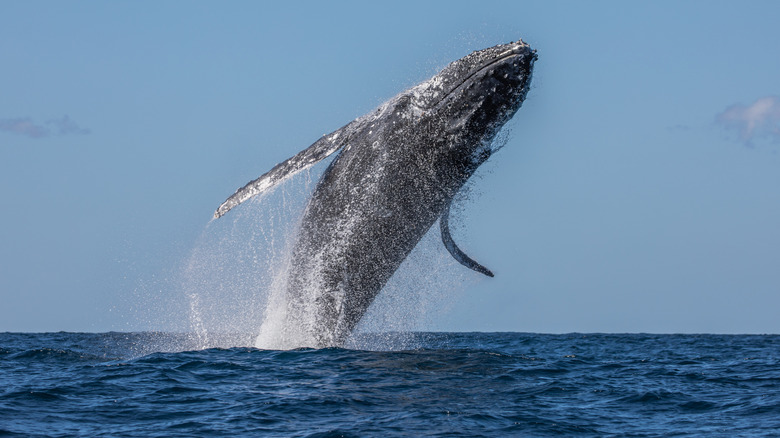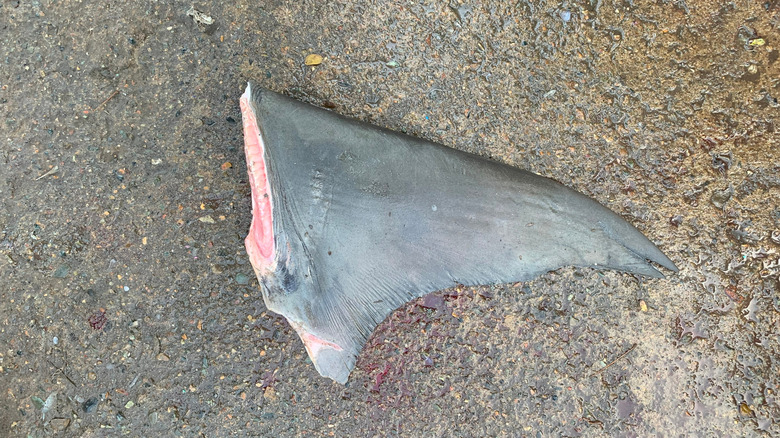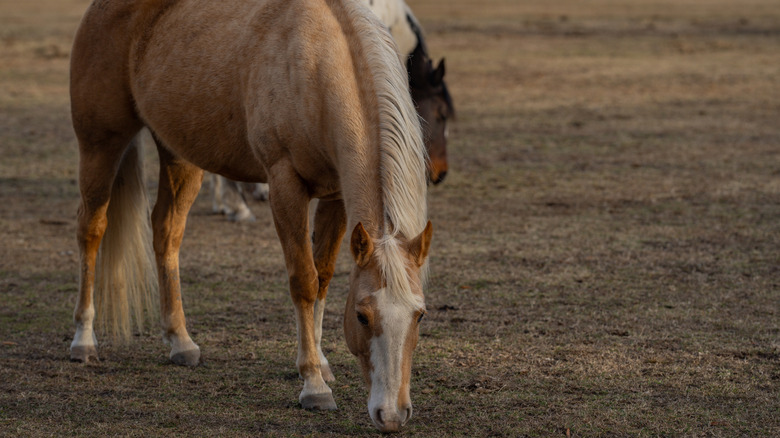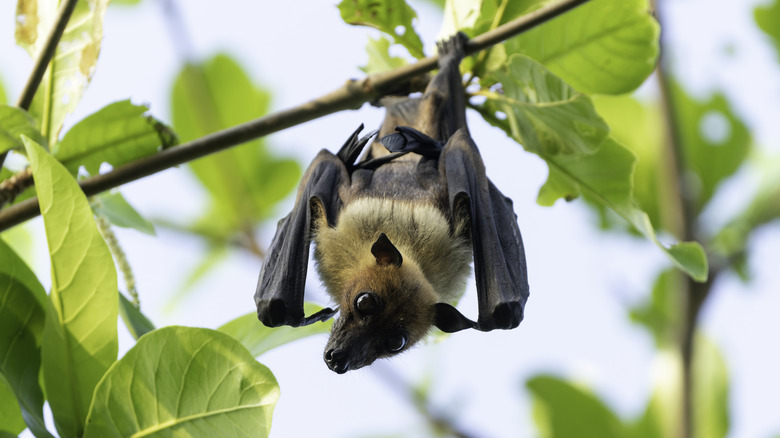10 Meats Americans Used To Eat, But Are Now Illegal
We may receive a commission on purchases made from links.
From the earliest cave-dwelling hominids to modern-day homo sapiens, humans have evolved to consume meat. Whether scavenged or hunted, meat, particularly in its cooked form, was vital to the development of the human brain. Without it, we never would have advanced our capacity to use tools and diversify our daily activities beyond sustenance.
Though early humans relied on the meat they could readily find in their native habitats, we have become increasingly discerning in the protein sources we deem palatable. Meats that were once considered commonplace are now among the most controversial foods on Earth. Some have fallen out of favor for practical reasons, such as concerns over safety or the potential extinction of a particular animal, while others have become taboo because of more emotional reasons, like certain animals being seen as companions.
Here in America, many of the meats that we once consumed regularly have been formally deemed illegal on both the state and federal levels. Some of these have been outlawed for decades, while others have been more recently banned. Read on to find out which meats used to be staples of our daily diets, but are now against the law to purchase and consume in the U.S.
1. Owls and Other Migratory Birds
Owls and other migratory birds have long been a food source for inhabitants of North America. Indigenous peoples relied on many species of waterfowl and migratory game birds for sustenance, ritual ceremonies, and medicinal purposes long before the arrival of Europeans. The early colonists also quickly learned which birds were safe to consume and how to prepare them, adopting them into their daily lives.
In 1918, much of this was halted when the Migratory Bird Treaty Act (MBTA) went into effect, which includes four international conservation treaties with Canada, Mexico, Japan, and Russia. According to the U.S. Fish & Wildlife Service, this law was intended to prohibit the killing, capturing, trade, and transport of any protected migratory bird species without prior authorization. Protected species include birds that exist in the U.S. and its territories as a result of natural biological or ecological processes, including several species of owl, loons, ortolans, robins, and puffins.
Though some exceptions have been built into the MBTA for the use of feathers of owls and migratory birds in various ceremonies by the hundreds of Native American tribes residing across the nation, to preserve their cultural heritage, any other violation of this treaty is subject to criminal prosecution. Knowingly taking a migratory bird is considered a felony offense and will earn you a fine of up to $250,000 and up to two years in prison for an individual.
2. Whale
Whaling and the consumption of whale meat have been an integral part of human subsistence globally for thousands of years. Though early colonists never really adopted the habit of eating whale meat from Indigenous peoples, they did continue to rely on this ocean-dwelling mammal's oil for fuel. It wasn't until the 20th century that laws were instituted to prohibit whaling, both domestically and internationally.
Some of the earliest laws curtailing whaling emerged internationally, including the International Whaling Convention (IWC), which was established in 1946. That said, it wasn't until 1986 that the IWC formally banned commercial whaling globally. Domestic laws protecting whales are manifold and include the Marine Mammal Protection Act, which was enacted in 1972, and the Endangered Species Act, which went into effect in 1973. Both of these effectively outlaw the killing, hunting, collecting, injuring, or harassing of whales.
Despite these laws, some whale consumption does continue legally in the U.S., particularly among Alaskan Natives. A total of 11 villages in the state are afforded exceptions allowing for the hunting of whales as part of traditional subsistence lifestyles, in accordance with cultural legacy. For these villages, whales represent an invaluable food source, helping mitigate food insecurity and provide numerous resources ranging from fuel to clothing.
3. Shark Fins
Shark fin soup has long been a delicacy in China and other Asian countries. While this dish was once reserved for the cultural elite, it has increasingly been enjoyed by mainstream populations in countries across the globe seeking to partake in the novelty. Unfortunately, it's a curiosity that comes with some significant costs. Not only can shark fins be toxic for human consumption, but the act of obtaining them has led to an alarming decline in global shark populations, which may eventually destroy entire marine ecosystems.
In order to harvest shark fins, sharks are often finned while still alive, before being thrown back into the ocean. Without fins, these sharks cannot propel themselves through the water, which means they quickly become oxygen-deprived and die. While many states in the U.S. have developed varying regulations curbing or banning the sale of shark fins, this has done little to mitigate their dissemination nationally.
On December 23, 2022, the Shark Fin Sales Elimination Act was passed by Congress, effectively prohibiting the sale, transport, and possession of shark fins in the U.S. This law has limited exceptions for shark fins used for noncommercial subsistence purposes and for those obtained by a museum, college, or university for scientific research with prior authorization. While the law has been more or less effective, there are still a number of cases where shark fins are being sold illegally under the table, highlighting the degree to which its regulation is challenging.
4. Horse
The inclusion of horse meat on this list is potentially confusing, as it's only partially banned in the U.S. but not outright illegal. That said, it has been the source of much controversy, particularly because it is incredibly popular elsewhere globally, which merits a discussion on the specifics of how to regulate it.
According to the World Population Review, horse meat is legal for human consumption in 17 countries, including our neighbors to the north and south, namely Canada and Mexico. On a federal level, the consumption of horse meat is not banned. That said, it is considered an amenable meat under the Federal Meat Inspection Act, which means it must be inspected by a licensed facility before it can be shipped or sold for human consumption. However, the inspection of horse slaughter plants by the USDA is banned by the federal government, so there's no way for horse meat to be commercially slaughtered and sold for human consumption in the U.S.
Several states have statewide bans on the consumption of horse meat, including California, Florida, Illinois, Massachusetts, Mississippi, New Jersey, New Mexico, New York, Oklahoma, and Texas. In the remaining states, while you cannot buy horse meat, there is nothing that would legally prevent someone from slaughtering their own horse and eating the meat in the privacy of their home.
5. Sea Turtle
The consumption of sea turtle meat and eggs has long been considered a delicacy. In some places, it's even integral to cultural identity. Ritual ceremonies abound, and sea turtle is purported to be something of a cure-all, promoting longevity and even being considered a potent aphrodisiac. In the U.S., turtles have long been enjoyed in recipes owing to their complex taste and versatility.
Unfortunately, the consumption of sea turtles comes with a number of pitfalls. First and foremost, all seven species of sea turtle are endangered, and their consumption has contributed markedly to the speed with which their populations have dwindled. Additionally, sea turtles can be potentially hazardous to consume. Not only are they capable of harboring pathogens, like Mycobacterium, Vibrio, Salmonella, and E. coli from the polluted waters they often live in, but they're highly susceptible to retaining toxic levels of environmental contaminants, like mercury and polychlorinated biphenyls or PCBs.
The consumption of sea turtles was effectively outlawed in the U.S. with the passage of the Endangered Species Act in 1973. This law criminalizes the harvest of sea turtles from U.S. waters. Additional protections exist under the Convention on International Trade in Endangered Species of Wild Fauna and Flora (CITES), which was introduced in 1975. This agreement further restricts the international trade of sea turtle meat by participating nations. Those wanting to experience the concept of turtle soup will have to rely on this AI-generated recipe to satisfy their curiosity.
6. Animal Lungs
One category of meat that's been faced with some controversy is animal lungs. While offal, in general, isn't especially popular in this country, internationally, organ meats are routinely enjoyed as a cost-effective and healthy means of obtaining protein and a head-to-tail approach to minimizing waste. Americans have not taken to this concept quite as readily, and some activists and scientists are seeking to change this.
The not-so-affectionately titled "haggis ban," which was enacted in 1971, prohibited the sale of animal lungs for human consumption, though they can still be used to produce pet food. Haggis is one of those must-try Scottish foods, and while the ban doesn't necessarily criminalize eating lung meat or dishes produced using lung meat, it does make it impossible to sell in the U.S.
One proponent of overturning the ban is Dr. Jonathan Reisman, author of "The Unseen Body." Reisman believes that the ban was not based on science, but rather on the perception that lung meat is somehow unclean because it is inherently spongy and can trap contaminants, including stomach fluids that can be transferred during the slaughtering process. He notes that these can be identified with proper inspection and that properly cooked is perfectly safe.
7. Bald and Golden Eagle
Bald and golden eagles have long been revered by Indigenous peoples of North America. While a handful of tribes have historically been known to eat these majestic birds of prey, they've featured more prominently in ritualistic ceremonies. Because of their importance to Native peoples and their symbolism as the official bird of the U.S., great measures have been taken to protect them.
These eagles are protected by a two-pronged approach. First, they are among the species afforded safety by the Migratory Bird Treaty Act of 1918, which also protects owls and a host of other birds. Bald and golden eagles are also safeguarded by the Bald and Golden Eagle Protection Act. Instituted in 1940, this act prohibits the taking of bald or golden eagles and any of their parts, including feathers, nests, or eggs. Violators of this act face a penalty of $100,000 and/or a year in prison. Subsequent violations are considered a felony.
Some exceptions exist for scientific, educational, depredation control, and religious purposes with proper permission from the U.S. Fish and Wildlife Service. Additionally, the federal government instituted the National Eagle Repository in 1970, developed to secure dead bald or golden eagles for the express purpose of delivering them to Native peoples for rituals. Permits can be obtained for their use from the U.S. Fish and Wildlife Service.
8. Dogs and Cats
Though it may be hard for most Americans to conceive of, many countries in the world still consume dog and cat meat on a relatively regular basis. According to the World Animal Foundation, as of 2024, 13 countries, predominantly in Asia, consume dog or cat meat. In most of these cases, the consumption of dogs or cats is limited and typically reserved for cultural rituals. In others, it may be the only meat that is readily available or that is affordable.
Believe it or not, until relatively recently, the consumption of cats and dogs in the U.S. was not outlawed. That said, it was illegal for slaughterhouses to process their meat, and grocery stores were forbidden from selling it. However, individuals could eat the meat of dogs and cats or sell it to their friends and relatives.
This changed in 2018 with the passage of the Dog and Cat Meat Trade Prohibition Act. This act bans the slaughter, transport, possession, sale, or donation of cat or dog meat for human consumption within the special maritime and territorial jurisdiction of the United States, with limited exceptions reserved for Native tribes. The penalty for violation of this act is a fine of $5,000 per dog or cat, which may not seem nearly high enough for those of us with beloved companion animals.
9. Seal
Seals and sea lions are another type of meat that's long been consumed by Indigenous peoples in North America. Not only have they been an integral part of their subsistence, but their slaughter has played a unique role in the delicate balance of ecosystems along the Pacific Northwest and beyond.
The taking and importing of seals and sea lions in U.S. waters and by U.S. citizens on the high seas is prohibited by several pieces of legislation. Not only are they protected by the Marine Mammal Protection Act of 1972, but some species are also included in the Endangered Species Act and the Convention on International Trade in Endangered Species of Wild Fauna and Flora (CITES), both of which were enacted in 1973.
While there are exceptions made for Indigenous peoples who rely on seal meat for subsistence, these exceptions are limited to a short period during which the harvest of seal and sea lion meat is legal, which many believe to be too restrictive. Additionally, tribal fishermen are sounding an alarm that the protective measures may have worked too well, leading to a boom in the seal and sea lion population that has been threatening other species of marine life, especially salmon. There are sound arguments suggesting that a more liberal approach to the harvest of seals and sea lions would help mitigate this overpopulation and restore the ecosystem balance.
10. Bat
Though it may not dawn on you to want to eat a bat, bushmeat is quite commonly consumed in several cultures across the globe. That said, it's controversial in the U.S. for a number of reasons, perhaps least of which is an ethical or moral aversion to consuming these flying creatures. Not only is bat meat potentially dangerous to consume owing to the number of diseases it can harbor, but many species of bats are considered endangered or threatened. While they may be a nuisance to some people, bats are an integral part of a healthy ecosystem. They are both effective pollinators, and they are necessary for the management of harmful insects, which carry disease.
Several states have laws on the books, protecting some or all species of bats — such as in California, where animal cruelty laws cover bats — but there's no federal law banning their consumption. That said, the Federal Endangered Species Act of 1973 and the Fish and Wildlife Coordination Act of 1956 both serve as safeguards protecting endangered or threatened species of bats, their breeding grounds, and their habitats from disruption. Additionally, the sale of bushmeat (including bat) from other countries is prohibited. Bushmeat in any form, including smoked, dried, or salted, will be confiscated, and violators are subject to a fine of $250,000.










